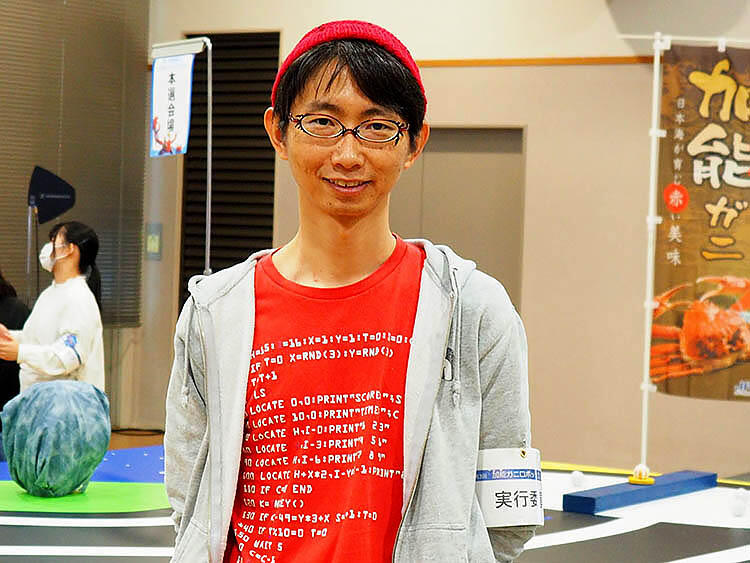
For the third installment of our feature, "Inventors who create the future," we interviewed Taisuke Fukuno, the founder of jig.jp Co., Ltd. (Sabae-City, Fukui Prefecture); a software development company, who created the kid's PC "IchigoJam (meaning strawberry jam)." Free-thinking manufacturing serves as the power to move and change society. He aims to nurture creative human resources, starting from programming, and provides practice opportunities. Where does the philosophy that Fukuno holds in "Create Every Day" come from?
"Raspberry Pi" - aware "IchigoJam"
IchigoJam is gaining popularity as an introductory personal computer specifically for programming. It is a small, palm-sized computer with which anyone can start programming right away by connecting a TV, keyboard, and power supply. Many people might wonder if this is really a computer from its cute appearance. Although its work area and programming area are small, IchigoJam is packed with the minimum functions required for a computer.
Another palm-sized computer, "Raspberry Pi," developed by a British foundation, requires preparations, like installing the necessary OS to run. Thinking that such work would be a hurdle for children, Fukuno pursued simpler operability for IchigoJam. He says the name "IchigoJam" was chosen while aware of Raspberry Pi. He was particular about making the price reasonable so that anyone would afford to buy it. His company provides places where people can practice programming as well.
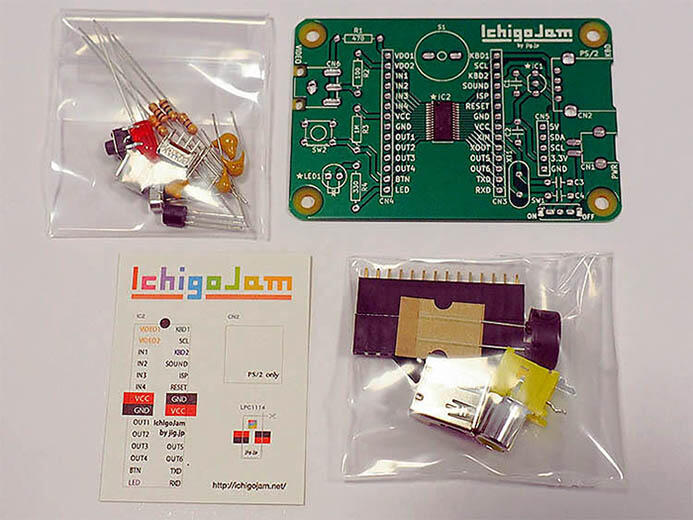
Programming is the process of telling a computer what to do in sequence. With IchigoJam, if you know the capital letters of the alphabet and have learned the basic patterns, you can make the computer perform various things by entering them as commands.
For example, entering "LED1" lights the attached LED (light-emitting diode), and entering "LED0" turns it off. "LED1:WAIT60:LED0" lights the LED for one second and then makes it turns off automatically. One of the fun things about this is to repeat trial and error until the computer performs your envisioned actions.
The kid's PC, IchigoJam, is also characterized by its immaturity, like the PC that was born 40 years ago. Although it does not have as high functionality and capacity as today's computers, children can create new inventions with free-thinking and simple operations.
For example, IchigoJam can make six input and output circuits that send commands to external equipment and execute the instructions. Making full use of these functions makes it possible to run your own self-made robot.
"Crab Robot Contest" held in three cities in the Hokuriku Region
The "Crab Robot Contest," a robot contest named after the crab, a local specialty, has taken place in three cities in Hokuriku Region: starting with Fukui-City in 2017, moving to Kanazawa-City in 2019, and recently, Uozu-City in 2021. In this contest, children compete over how many missions they can accomplish in a given amount of time while moving the crab-shaped robots they respectively made.
The children control these crab by programming various devices embedded into the robots, such as motors that move the legs and sensors that serve as eyesight. If things don't go well, they can modify the program on the spot and try again. The children are serious as they demonstrate the skills of their all original-made robots, from design to motion control.
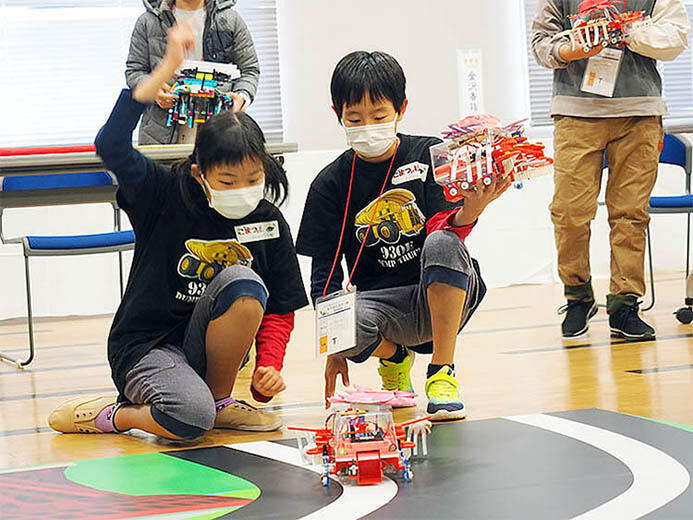
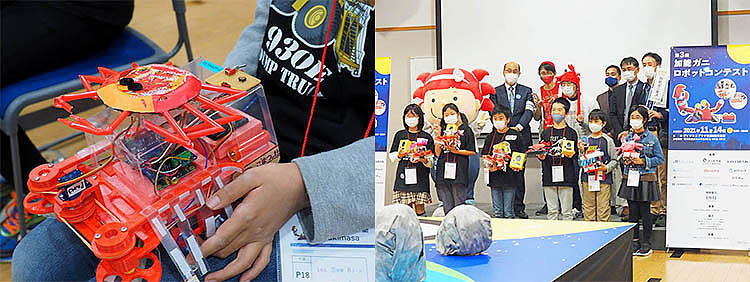
The feedback from the children who participated in the contest includes, "Fine adjustment is difficult, but it's worthwhile," "I thought I was done, but succeed after trying again. That's the fun part." The venue is full of energy throughout the contest.
Increasing the number of colleagues who would change society by creating things
The "Crab Robot Contest," which livened up three cities of the Hokuriku Region, has another gimmick ― developing activities in cooperation with local companies. For example, its meeting rooms on holidays are open to the public for programming classes and practice places, involving many adults in daily activities. On the day of the contest, the entire company is there to cheer for the event; It is an initiative everyone gets excited about, from children to adults.
Fukuno's activities include his desire to "increase the number of colleagues across Japan and worldwide who would aspire to create things."
He says, "There are mountains of things I want to create, and I can't make them all alone. I want to work with people to take on the challenge of creating things from various perspectives, contribute to social issues, and entertain people worldwide. I want everyone to become a creator."
Today, there are too many unsolved problems. Adults provide the technologies they have built up in an easy-to-reach form to the younger generation, who will use them to take the next step forward. The fact that IchigoJam was invented with a focus on design, functionality, and a price accessible to everyone includes the hope that it will help with a smooth first step toward becoming a creator. It is a gimmick to increase the number of "colleagues who would change society by creating things."
Dissatisfaction becomes the seed of invention
Fukuno is a graduate of the National Institute of Technology, Fukui College, and has created things since he was there. After graduating, he set up his company that makes things following his will to "Give shape to what I want to create on my own." He is also promoting the "Programming Club Network (PCN)," an activity led by graduates of the National Institute of Technology, Fukui College, to expand the programming opportunities for children so that they can acquire problem-solving skills using IT while having fun.
What is it that drives Fukuno to create new things constantly?
Fukuno says that creativity derives from dissatisfaction and discomfort. If you are dissatisfied with something, you may solve it by creating something. If you feel uncomfortable with something, you think about the ideal situation and create something that will bring you one step closer to it. He believes it is wasteful to do nothing and only resent dissatisfaction and discomfort.
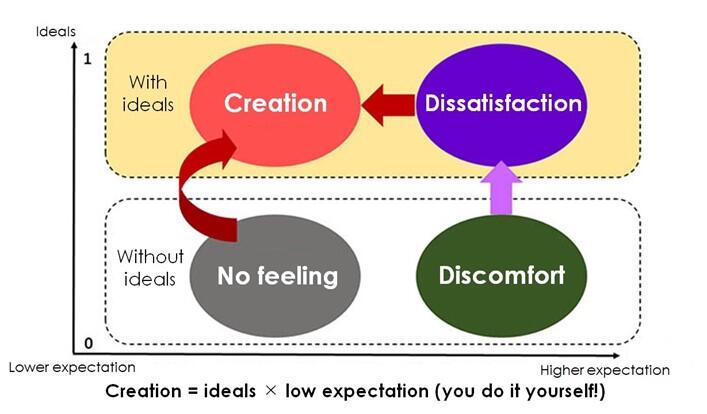
(Created by the editorial staff based on Fukuno's explanation)
For example, if you get the discomforting awareness of "difficulty getting to this place with a wheelchair," it makes you start making something to solve the problem. Once the image of what you want to create and your motivation are fixed, the way you move to the next step will change.
Because the world is full of problems, each of you should be free to choose your favorite theme and work on it. With this in mind, Fukuno gives children a push.
He concluded the interview by saying, "Dissatisfaction becomes the seed of the invention, and there is no end to the possibilities in this. I hope you feel lucky whenever you find a moment of dissatisfaction," and gave a smile.
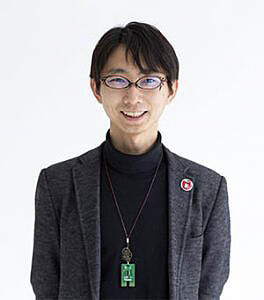
FUKUNO Taisuke
Founder & Chairman of jig.jp Co., Ltd., Developer of the kid's PC IchigoJam
Graduate of the Department of Electronics and Information Engineering, National Institute of Technology, Fukui College. He developed the jig browser at jig.jp, the third company he founded, where he started "Create every day" to create and present something every day. He is also Co-founder of PCN and has served in several capacities like Open Data Evangelist for the Government of Japan and Local Informatization Advisor for the Ministry of Internal Affairs and Communications.
Original article was provided by the Science Portal and has been translated by Science Japan.




